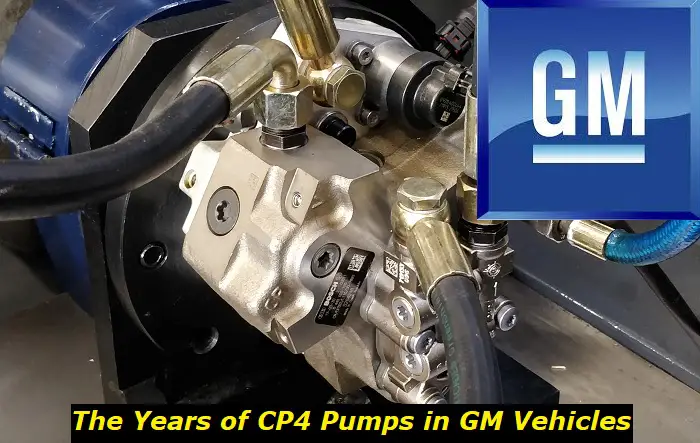What Years Did GM Use CP4 Pump? Timeline and Impact
The CP4 pump, a vital component in the fuel system of heavy-duty vehicles, has been utilized by General Motors (GM) in a number of their vehicles over the years. This intricately designed pump is integral in the operation of diesel engines, assisting in the distribution and pressurizing of fuel. The usage of the CP4 pump by GM spanned prominently from 2011 up to 2016.
This article aims to delve into the specifics of the CP4 pump's function, its integration timeline within GM vehicles, the pros and cons of their implementation, as well as signs and solutions for possible pump failure. Our focus will be on notable models and specific periods of GM's usage of the CP4 pump, providing a comprehensive understanding for mechanics specializing in heavy-duty machinery.

Introduction: The Introduction to the CP4 Pump
Welcome to the fascinating world of heavy machinery! When speaking about integral parts, the conversation wouldn't be complete without mentioning the famed CP4 pump. This component, often deemed a 'heartbeat' of the engine, is paramount in the function of diesel vehicles, particularly in those produced by none other than General Motors (GM).
The CP4 pump, the successor to the reliable CP3, is a high-pressure fuel pump designed to deliver adequately pressurized fuel to the engine of a vehicle. It is robust, efficient, and meticulously engineered to ensure optimal fuel combustion. This is achieved by maintaining its pressurizing prowess even at high speeds-a characteristic that has made it a mainstay in certain models of GM vehicles, particularly heavy-duty diesel ones.
However, in our exploration of the CP4 pump's usage, we should not overlook that its utilization by GM wasn't without controversies. That said, the pump's functionality remains indisputable and has carved its niche in the compact heavy-duty diesel engine segment. Understanding the CP4 pump requires a keen interest in the intricacies of mechanical engineering and an appreciation for the art of vehicle functionality. Its role in maintaining the effective operation of GM vehicles is seminal and forms the bedrock of our discussion here.
Understanding the Functionality of the CP4 Pump
When it comes to the smooth operation and performance of a vehicle, the fuel delivery system plays a vital role. In the world of diesel engines, one component that stands out for its prominent role is the CP4 pump. But what does it do?
The CP4 pump is a part of the high-pressure fuel injection system and its primary role is to pressurize the fuel. This high-pressure fuel is then delivered to the engine's injectors, which squirt it into the cylinders where it then combusts to power the engine. The pressure from the pump helps the fuel atomize, or split into tiny droplets, which is crucial for efficient combustion. This burning process is what creates the power needed to move your GM vehicle reliably down the road.
To perform this role, the CP4 pump uses a clever design that features two plungers to pressurize the fuel. These plungers compress the fuel, increasing its pressure before it makes its way to the injectors. The CP4 pump is specifically built to withstand the stresses of these high-pressure operations.
Now, here's where the significance comes in, the CP4 pump is not just any regular component-it's specifically designed to function in high-capacity, high-output engines, particularly those found in heavy-duty vehicles. This can include trucks, SUVs, and other large GM vehicles with powerful diesel engines.
It's important to note, while the CP4 pump offers advantages with its design, it requires specific maintenance and attention to function effectively. Incorrect usage or upkeep can result in pump failure, which affects the overall performance of the vehicle.
In essence, the CP4 pump is a hardworking, high-pressure fuel pressurizer, integral to proper combustion and vehicle propulsion. Its prominent usage by GM in various models speaks volumes about its importance in heavy machinery.
By the way, have a look at the fuel shut-off solenoid problems article.
The Timeline: Detailing When GM Implemented the CP4 Pump
In an endeavor to constantly improve their models, General Motors (GM) introduced the CP4 pump in 2011. This marked a new era in fuel efficiency and performance with the adaptation of this technically superior fuel pump. The CP4 pump was integrated into the wider GM family, including pickup trucks, vans and SUVs that were equipped with GM's Duramax engine.
GM utilized the Bosch CP4.2, which was a notable progress from the earlier CP3 model. The CP4.2 pump's primary role was to enhance the fuel flow in the engine and promote better combustion, thereby improving power output and fuel efficiency. Setting new highs in the automotive industry, this pump was critical for the Duramax diesel engine operation spanning various makes and models of GM vehicles.
The use of the CP4 pump by GM continued prominently throughout the subsequent years, extending up until 2016. It must be noted that GM shifted to a new Denso high pressure pump in some of its 2017 models, signalling an end to the prominent CP4 era. GM's journey with the CP4 pump, though limited to a span of around half a decade, brought significant strides in vehicle performance.
The Pros and Cons of GM's Use of the CP4 Pump during Those Years
The years of GM using the CP4 injection pump were marked by both advantages and challenges. Delving into the positive sides, one of the chief benefits of GM using the CP4 pump was performance enhancement. The CP4 pump was engineered to improve fuel efficiency and combustion, optimal for the heavy-duty GM vehicles that require consistent high performance.
Furthermore, the CP4 pump played a significant role in minimizing harmful emissions, aligning GM's vehicles with stringent environmental regulations. The precise diesel distribution and improved combustion the CP4 pump offers indirectly mitigated the diesel particulates released into the environment.
Despite these advantages, GM's use of the CP4 pump was not without its complications. One primary concern was the pump's susceptibility to damage following fuel contamination. High-pressure systems like the CP4 pump depend heavily on the lubrication properties of diesel. If fuel quality is not up to standard, internal components of the pump can wear quickly, leading to premature pump failure. This was a predominant issue with GM's earlier generation of CP4 pumps, which were not designed to handle poor-quality fuel.
A repeat problem of the pump was its high maintenance requirements. A flawed CP4 pump can significantly affect the vehicle performance, often necessitating frequent check-ups and timely replacements. Such maintenance demands posed challenges for users who relied heavily on their GM vehicles for daily operations.
Notwithstanding these challenges, it's important to note that the use of CP4 pump brought about noteworthy advancements in the operation of GM's heavy-duty vehicles. The key, as always, comes down to proper regular maintenance and quality fuel usage to leverage the benefits the CP4 pump offers.
Notable Models: Diving Deeper into Which GM Vehicles Included the CP4 Pump
GM's usage of the CP4 pump wasn't limited to a single model. In truth, it formed part of the core mechanics in many of their heavy-duty vehicle models. It was an essential element for these, as it assisted in controlling fuel delivery to the engines, thereby impacting performance and power output.
One of the most prominent of these vehicles where the CP4 pump was utilized is the Chevrolet Silverado HD. The 2011-2016 models of this vehicle, more so those equipped with a 6.6L Duramax Diesel engine, specifically incorporated the CP4 pump. This pump became an integral component of this high-performance, heavy-duty truck model for these years.
Another vehicle that sported the CP4 pump was the GMC Sierra HD. Similar to the Silverado, models from the years 2011-2016 running on the 6.6L Duramax diesel engine featured the CP4 pump. The Sierra, known for its power and reliability, found the inclusion of the CP4 pump beneficial from both performance and efficiency standpoints.
Apart from these, GM also integrated the CP4 pump into their mid-sized pickup models, the GMC Canyon and the Chevrolet Colorado. These models, between the years 2016 and 2022, equipped with the 2.8L Duramax diesel engine, included the trustworthy CP4 fuel pump.
While these are just a selection of the GM vehicles that included the CP4 pump, they highlight its consistent usage by GM across their heavy-duty diesel models. This further emphasizes the CP4 pump's importance in shaping the performance of these vehicles.
CP4 Pump Failure Symptoms and Solutions in GM Vehicles
Diagnosing a failing CP4 pump is a critical competency every heavy-duty machinery mechanic should possess. Recognizing the warning signs and knowing how to address them can prolong the lifespan of your GM vehicle significantly.
The most common symptom of a failing CP4 pump is a decline in overall engine performance. This is often characterized by difficulty in starting the vehicle or repeated stalling, which can be quite noticeable. Moreover, a failing CP4 pump may even cause noticeable and often loud noise from the engine compartment, usually indicating a deficiency in the fuel system.
A sudden decrease in fuel efficiency can also be indicative of a potential CP4 pump problem. This occurs because the failing pump is unable to efficiently pressurize and circulate fuel through the engine. A critical factor would also be any instances of metal shavings found in the fuel, an alarming sign pointing towards possible CP4 pump failure. This happens when the internal components of the pump start wearing down, releasing metal particles into the fuel system, which could even lead to total engine failure if not addressed promptly.
When confronted with these symptoms, it's important to seek professional help immediately. Usually, the course of action involves replacing the CP4 pump entirely. However, with a comprehensive understanding of the system, some mechanics opt to rebuild the pump, effectively restoring its functionality. Furthermore, frequent maintenance checks and the use of high-quality diesel fuel can prevent premature wear and tear of the CP4 pump, ensuring its optimal functionality.
Naturally, these are complex procedures and should be conducted by professionals. As an experienced mechanic in heavy machinery, possessing the knowledge about the functioning of the CP4 pump can make a significant difference in the vehicle's performance and longevity.

Add comment